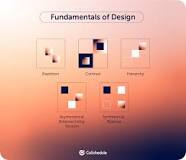The Art of Visual Identity Development
Visual identity development is a crucial aspect of branding that encompasses the creation of a consistent and recognisable visual language for a company or organisation. It goes beyond just designing a logo; it involves crafting a visual system that conveys the brand’s values, personality, and message cohesively across various touchpoints.
Key Elements of Visual Identity
A well-developed visual identity consists of several key elements:
- Logo: The central element of the visual identity, the logo serves as the primary symbol that represents the brand.
- Colour Palette: A carefully selected range of colours that reflect the brand’s personality and evoke specific emotions.
- Typography: The choice of fonts and typography styles that complement the brand’s voice and enhance readability.
- Imagery: The use of photography, illustrations, or graphics that align with the brand’s aesthetics and messaging.
- Design Elements: Consistent graphic elements such as patterns, shapes, or icons that reinforce the brand’s visual language.
The Process of Visual Identity Development
The development of a visual identity typically involves several stages:
- Research: Understanding the brand’s values, target audience, competitors, and market trends to inform design decisions.
- Ideation: Brainstorming concepts and exploring different design directions based on research insights.
- Design Development: Creating initial design concepts for the logo, colour palette, typography, and other visual elements.
- Refinement: Iterating on designs based on feedback and making adjustments to ensure consistency and alignment with the brand strategy.
- Implementation: Applying the finalised visual identity across various brand touchpoints such as websites, marketing materials, packaging, etc.
The Impact of Strong Visual Identity
A strong visual identity can have significant benefits for a brand:
- Credibility: A consistent and professional visual identity instils trust and credibility among customers and stakeholders.
- Differentiation: Distinctive visuals help a brand stand out in a crowded marketplace and create a memorable impression.
- Cohesion:A cohesive visual identity unifies all brand communications and reinforces its core values consistently.
In conclusion, visual identity development is an art form that requires thoughtful planning, creativity, and attention to detail. By investing in creating a strong visual identity, brands can establish a lasting connection with their audience and leave a lasting impression in their minds.
Understanding Visual Identity: Key Components, Purposes, Importance, and Examples
- What are the 4 main components of visual identity?
- What are the three purposes of visual identity?
- How important is visual identity?
- What is a visual identity example?
What are the 4 main components of visual identity?
When exploring the frequently asked question regarding the main components of visual identity, it is essential to highlight the four key elements that form the foundation of a cohesive and impactful visual identity. These components typically include the logo, colour palette, typography, and imagery. The logo serves as the central symbol that represents the brand, while the colour palette evokes specific emotions and reinforces brand personality. Typography plays a crucial role in enhancing readability and conveying brand voice, while imagery, whether through photography or graphics, aligns with the brand’s aesthetics and messaging. Together, these components work harmoniously to create a visual language that communicates the essence of a brand effectively across various platforms and mediums.
What are the three purposes of visual identity?
The three primary purposes of visual identity are to establish brand recognition, convey brand values and personality, and create a consistent brand image across various platforms. By having a distinct visual identity, a brand can be easily recognised by its audience, differentiate itself from competitors, and build trust and credibility. Additionally, a well-crafted visual identity helps communicate the brand’s core values and messaging effectively, resonating with the target audience on an emotional level. Lastly, maintaining consistency in visual elements such as logo, colours, typography, and design style ensures that the brand presents a cohesive image that reinforces its identity and message.
How important is visual identity?
Visual identity plays a pivotal role in shaping how a brand is perceived by its audience and stakeholders. It serves as the face of the brand, conveying its personality, values, and essence visually. A strong visual identity not only helps differentiate a brand from its competitors but also fosters recognition and trust among consumers. Consistency in visual elements such as logos, colours, typography, and imagery across various touchpoints reinforces brand recall and strengthens brand positioning. In essence, visual identity is crucial in creating a cohesive and memorable brand image that resonates with target audiences and leaves a lasting impact on their perception of the brand.
What is a visual identity example?
A visual identity example can be seen in the branding of well-known companies such as Apple, Nike, or Coca-Cola. These brands have distinct visual elements that are instantly recognisable and consistently used across various platforms. For instance, Apple’s sleek logo, minimalist design aesthetic, and use of white space convey a sense of innovation and sophistication. Similarly, Nike’s iconic swoosh symbolises movement and empowerment, while Coca-Cola’s classic red colour scheme and scripted logo evoke feelings of nostalgia and happiness. These visual identity examples demonstrate how a cohesive and well-crafted design system can effectively communicate a brand’s values and resonate with its target audience.
